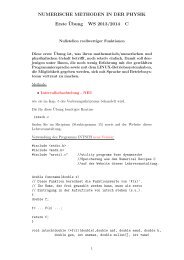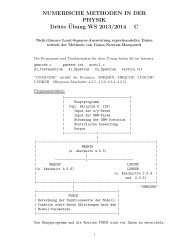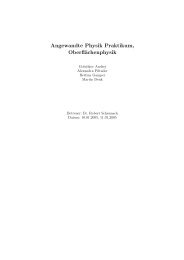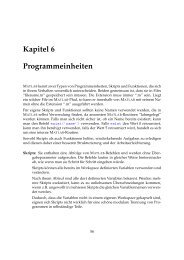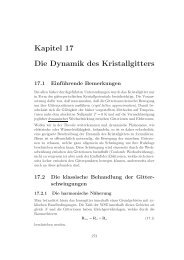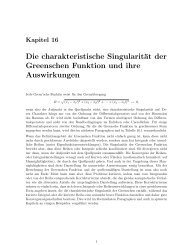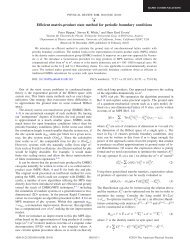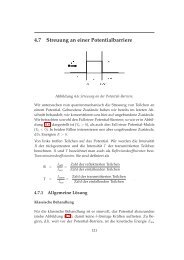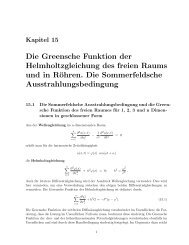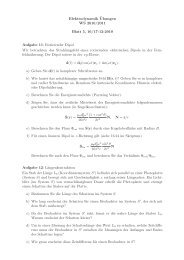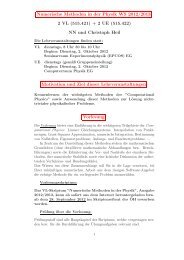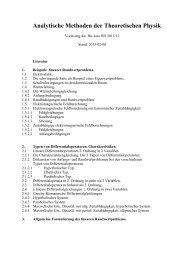Pseudogaps and Their Interplay with Magnetic Excitations in the ...
Pseudogaps and Their Interplay with Magnetic Excitations in the ...
Pseudogaps and Their Interplay with Magnetic Excitations in the ...
You also want an ePaper? Increase the reach of your titles
YUMPU automatically turns print PDFs into web optimized ePapers that Google loves.
VOLUME 79, NUMBER 6 PHYSICAL REVIEW LETTERS 11AUGUST 1997<br />
H 2 t X<br />
c<br />
ij,s<br />
y<br />
i,scj,s 1 H.c. 1 U X<br />
ni"ni#<br />
i<br />
2m X<br />
In addition, a portion of <strong>the</strong> large Fermi surface, which<br />
is closed around p, p at T 0.33t [i.e., has Fermi<br />
level cross<strong>in</strong>gs between p,0 <strong>and</strong> p, p as well as<br />
ni" 1ni# (1) between p, p <strong>and</strong> 0, 0], seems to disappear at <strong>the</strong> lower<br />
i<br />
temperature, T 0.25t. This is <strong>in</strong>dicated <strong>in</strong> Fig. 1(a)<br />
by <strong>the</strong> downturn of <strong>the</strong> quasi-particle-like b<strong>and</strong> between<br />
p,0<strong>and</strong> p, p. In <strong>the</strong> experiment, this behavior <strong>in</strong> <strong>the</strong><br />
underdoped regime has been <strong>in</strong>terpreted as <strong>the</strong> open<strong>in</strong>g<br />
of a pseudogap <strong>in</strong> <strong>the</strong> underly<strong>in</strong>g Fermi surface near <strong>the</strong><br />
p,0to p, p l<strong>in</strong>e [1]. The momentum dependence of<br />
<strong>the</strong> pseudogap is also <strong>in</strong> agreement <strong>with</strong> experiment <strong>in</strong> that<br />
its largest value, which is of <strong>the</strong> order of <strong>the</strong> exchange<br />
coupl<strong>in</strong>g J 4t2U, occurs near p,0 <strong>and</strong> <strong>in</strong> that it<br />
essentially vanishes along <strong>the</strong> 0, 0 to p, p l<strong>in</strong>e. This<br />
on a square lattice, where t is <strong>the</strong> nearest-neighbor<br />
hopp<strong>in</strong>g, ci,s destroys a particle of sp<strong>in</strong> s on site i, <strong>and</strong><br />
nis c y<br />
i,sci,s. The chemical potential m sets <strong>the</strong> fill<strong>in</strong>g<br />
n ni" 1 ni#. The spectral weight A k, v is <strong>in</strong>ferred<br />
from high-quality [13] QMC data by apply<strong>in</strong>g state-of<strong>the</strong>-art<br />
“maximum-entropy” techniques [14]. This method<br />
has previously been used to resolve a quasi-particle-like<br />
dispersive b<strong>and</strong> of width J at half-fill<strong>in</strong>g <strong>and</strong> to follow its<br />
evolution from <strong>the</strong> <strong>in</strong>sulator to <strong>the</strong> metal [12].<br />
In Fig. 1(a) we compare <strong>the</strong> QMC results for <strong>the</strong> s<strong>in</strong>gleparticle<br />
spectral weight A k, v for <strong>the</strong> underdoped (1%<br />
<strong>and</strong> 5%) <strong>and</strong> maximally doped (13%) regimes <strong>with</strong> <strong>the</strong><br />
ARPES data from Ref. [1] <strong>in</strong> Fig. 1(b). The <strong>the</strong>oretical<br />
results were obta<strong>in</strong>ed for temperatures of T 0.33t <strong>and</strong><br />
T 0.25t, on-site Coulomb repulsion U 8t, <strong>and</strong> 8 3 8<br />
lattices. To facilitate detailed comparison <strong>with</strong> Fig. 1(b)<br />
of Marshall et al. [1], we use <strong>in</strong> Fig. 1(a) <strong>the</strong> same v vs k<br />
“b<strong>and</strong> structure” plot <strong>with</strong> all spectra referr<strong>in</strong>g to <strong>the</strong> same<br />
chemical potential m v 0.<br />
In accordance <strong>with</strong> <strong>the</strong> ARPES data, we f<strong>in</strong>d a dramatic<br />
change <strong>in</strong> <strong>the</strong> electronic structure near p,0<strong>with</strong> dop<strong>in</strong>g.<br />
In <strong>the</strong> underdoped (1% <strong>and</strong> 5%) regime, <strong>the</strong> features<br />
near p,0 move to lower b<strong>in</strong>d<strong>in</strong>g energy as dop<strong>in</strong>g<br />
is <strong>in</strong>creased. At about 13% dop<strong>in</strong>g [15] [full circle <strong>in</strong><br />
Fig. 1(a)] <strong>the</strong> pseudogap vanishes.<br />
FIG. 1. The dispersion of <strong>the</strong> peaks <strong>in</strong> <strong>the</strong> s<strong>in</strong>gle-particle spectral<br />
weight from (a) QMC simulations of <strong>the</strong> Hubbard model at<br />
densities rang<strong>in</strong>g from <strong>the</strong> underdoped to <strong>the</strong> maximally doped<br />
regime where peaks <strong>in</strong> A k, v are represented by error bars<br />
<strong>and</strong> (b) peak centroids <strong>in</strong> A k, v from underdoped <strong>and</strong> maximally<br />
doped ARPES experiments after Ref. [1].<br />
behavior is consistent <strong>with</strong> dx22y2 symmetry. At 13%<br />
dop<strong>in</strong>g we obta<strong>in</strong> a Fermi surface cross<strong>in</strong>g near p,0<br />
[full circle <strong>in</strong> Fig. 1(a)] <strong>in</strong>dependent of <strong>the</strong> two chosen<br />
temperatures. Thus, at optimal hole dop<strong>in</strong>g <strong>the</strong> Fermi<br />
surface is large, consistent <strong>with</strong> both ARPES [1–4] <strong>and</strong><br />
earlier QMC calculations [12,15].<br />
In <strong>the</strong> QMC simulation, <strong>the</strong> disappearance of Fermi surface<br />
cross<strong>in</strong>gs shows up below a “crossover” temperature<br />
T 0.3t <strong>in</strong> terms of a systematic shift of <strong>the</strong> <strong>in</strong>tegrated<br />
spectral weight near p, p <strong>in</strong> <strong>the</strong> underdoped regime.<br />
To illustrate this crossover, we consider <strong>in</strong> Figs. 2(a) <strong>and</strong><br />
2(b) <strong>the</strong> role played by temperature <strong>and</strong> its <strong>in</strong>fluence on<br />
<strong>the</strong> spectral weight distribution <strong>in</strong> more detail. We observe<br />
two general features <strong>in</strong> both spectra: a (several t)<br />
broad “<strong>in</strong>coherent background” both below <strong>and</strong> above <strong>the</strong><br />
Fermi surface <strong>and</strong> a dispers<strong>in</strong>g structure <strong>with</strong> a smaller<br />
width of order of a few J around v m. In our earlier<br />
work [12] <strong>in</strong> which <strong>the</strong> lowest temperature accessible<br />
was T 0.33t, this dispers<strong>in</strong>g quasi-particle-like<br />
b<strong>and</strong> was shown to have its maximum at p, p. In<br />
this case, which is reproduced <strong>in</strong> Fig. 2(a), <strong>the</strong>re is a<br />
“large” Fermi surface centered around p, p. However,<br />
by lower<strong>in</strong>g <strong>the</strong> temperature to T 0.25t, <strong>the</strong> structure<br />
form<strong>in</strong>g <strong>the</strong> maximum at p, p loses <strong>in</strong>tegrated spectral<br />
weight <strong>and</strong> <strong>the</strong> new valence-b<strong>and</strong> maximum seems to be<br />
shifted to p2, p2 or p,0[Fig. 2(b)] [16]. In agreement<br />
<strong>with</strong> <strong>the</strong> ARPES data <strong>in</strong> Fig. 1(b), we observe <strong>the</strong><br />
downturn (“shadow” structure) as well as a drastic (by<br />
about a factor of 10) spectral weight loss when follow<strong>in</strong>g<br />
<strong>the</strong> quasiparticle b<strong>and</strong> from p,0 to p, p. It is well<br />
known [17] that <strong>in</strong>clusion of higher-neighbor (t0 , etc.) <strong>in</strong>teractions<br />
lifts <strong>the</strong> degeneracy of <strong>the</strong> po<strong>in</strong>ts p2, p2<br />
<strong>and</strong> p,0 at half-fill<strong>in</strong>g <strong>and</strong> pushes <strong>the</strong> p2, p2<br />
po<strong>in</strong>t up <strong>in</strong> energy. This opens up <strong>the</strong> possibility of a<br />
small Fermi surface (“hole pockets”) around p2, p2<br />
[11,18]. The full l<strong>in</strong>e <strong>in</strong> Fig. 2(b), which plots our results<br />
for <strong>the</strong> same temperature for <strong>the</strong> <strong>in</strong>sulat<strong>in</strong>g case, n <br />
1.0, <strong>in</strong>dicates <strong>the</strong> similarities between <strong>the</strong> 7% doped<br />
situation <strong>and</strong> <strong>the</strong> antiferromagnetic b<strong>and</strong> structure at<br />
half-fill<strong>in</strong>g.<br />
The physical orig<strong>in</strong> of a possible manifestation of <strong>in</strong>sulat<strong>in</strong>g<br />
b<strong>and</strong> features <strong>in</strong> <strong>the</strong> underdoped regime seems to<br />
be that around <strong>the</strong> temperature T 0.3t <strong>the</strong> antiferro-<br />
1123



